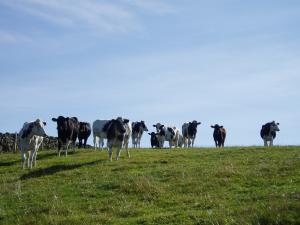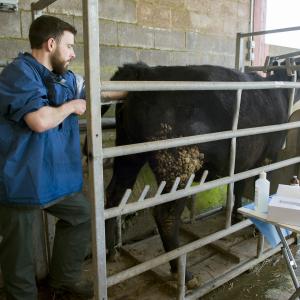
By Vet Rob Simmons
Historically, advanced breeding techniques in cattle have been seen to be the reserve of elite breeders looking to increase the number of calves born from their best show animals, to ensure their next generation show team is the best it can possibly be.
But more and more farmers are now utilising these techniques and seeing the benefits in their own herds.

Advanced breeding covers a range of techniques including embryo flushing, IVF, embryo transfer and even semen collection for storage and artificial insemination (AI). The basis for the majority of these is to improve reproductive efficiency and genetic improvement, by producing more calves from the best dams and sires available. The use of AI pioneered more rapid genetic improvement, allowing the best bulls to sire many thousands of calves worldwide, but the bull is only half of the equation!
The introduction of genomics to dairy cattle, and its development in a number of beef breeds, allows producers to identify their commercial animals with the most potential at an early stage, and consider the benefits that more selective breeding could achieve. This may range from choosing to breed replacement heifers from the better end of their herd, to amplifying the number of calves produced from their very best cattle by using IVF or flushing to generate embryos, and implanting these into some of their poorer animals - one additional benefit of genomic testing is the identification of animals which have good fertility, but poor production, which would make for ideal embryo recipients.
These benefits speed up the genetic progress of a herd, with some studies suggesting around 7 years of genetic progress through AI-only can be achieved within a year utilising embryo transfer.
Most farms have stock which outperforms the rest of the herd, and this can be very specific to the farm or farming system and whilst I heard it said jokingly a number of times: “I wish I had 20 more like her!” these aspirations could become reality!
In addition to this, the increased number of embryos being produced and available for sale opens the door for anyone with an interest in breeding stock to start buying high genetic embryos and implanting them on their own farms.

There has also been an increase in the use of repeat breeder, or ‘cowstopper’ embryos recently. This tends to be reserved for animals which fail to hold in calf after a number of services. When used, the animal is bred as per usual to either a natural or synchronised heat, and an additional embryo is transferred a week later. This helps the pregnancy to be recognised and can boost conception rates to around 50% (with most live calves being to the service, rather than the embryo).
Advanced breeding techniques have an important role to play in improving the sustainability of agriculture. Breeding and genetics have been identified as key to maintaining milk and beef production in a methane-efficient manner, with genomic markers having been identified to help breeders select for the most carbon-efficient animals.
There can be up to a 15% difference in methane production between dairy cows fed the same diet, and producing the same volume and constituents of milk, and this is genetically driven. The use of these selection techniques with IVF will accelerate herd genetic progress in this field, rapidly improving the sustainability of the UK dairy and beef industries, to the benefit of all.
It is important to involve your vet from the outset, as they can help with selecting the most appropriate animals, minimising stress and disease and ensuring the diets and husbandry are correct to give you the best results possible. Attention to detail is crucial in all aspects of cattle reproduction.